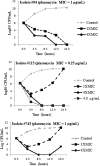Carbapenem-resistant Klebsiella pneumoniae strains exhibit diversity in aminoglycoside-modifying enzymes, which exert differing effects on plazomicin and other agents
- PMID: 24867988
- PMCID: PMC4135979
- DOI: 10.1128/AAC.00099-14
Carbapenem-resistant Klebsiella pneumoniae strains exhibit diversity in aminoglycoside-modifying enzymes, which exert differing effects on plazomicin and other agents
Abstract
We measured in vitro activity of plazomicin, a next-generation aminoglycoside, and other aminoglycosides against 50 carbapenem-resistant Klebsiella pneumoniae strains from two centers and correlated the results with the presence of various aminoglycoside-modifying enzymes (AMEs). Ninety-four percent of strains were sequence type 258 (ST258) clones, which exhibited 5 ompK36 genotypes; 80% and 10% of strains produced Klebsiella pneumoniae carbapenemase 2 (KPC-2) and KPC-3, respectively. Ninety-eight percent of strains possessed AMEs, including AAC(6')-Ib (98%), APH(3')-Ia (56%), AAC(3)-IV (38%), and ANT(2")-Ia (2%). Gentamicin, tobramycin, and amikacin nonsusceptibility rates were 40, 98, and 16%, respectively. Plazomicin MICs ranged from 0.25 to 1 μg/ml. Tobramycin and plazomicin MICs correlated with gentamicin MICs (r = 0.75 and 0.57, respectively). Plazomicin exerted bactericidal activity against 17% (1× MIC) and 94% (4× MIC) of strains. All strains with AAC(6')-Ib were tobramycin-resistant; 16% were nonsusceptible to amikacin. AAC(6')-Ib combined with another AME was associated with higher gentamicin, tobramycin, and plazomicin MICs than AAC(6')-Ib alone (P = 0.01, 0.0008, and 0.046, respectively). The presence of AAC(3)-IV in a strain was also associated with higher gentamicin, tobramycin, and plazomicin MICs (P = 0.0006, P < 0.0001, and P = 0.01, respectively). The combination of AAC(6')-Ib and another AME, the presence of AAC(3)-IV, and the presence of APH(3')-Ia were each associated with gentamicin resistance (P = 0.0002, 0.003, and 0.01, respectively). In conclusion, carbapenem-resistant K. pneumoniae strains (including ST258 clones) exhibit highly diverse antimicrobial resistance genotypes and phenotypes. Plazomicin may offer a treatment option against strains resistant to other aminoglycosides. The development of molecular assays that predict antimicrobial responses among carbapenem-resistant K. pneumoniae strains should be a research priority.
Copyright © 2014, American Society for Microbiology. All Rights Reserved.
Figures





References
-
- Rice LB, Carias LL, Hutton RA, Rudin SD, Endimiani A, Bonomo RA. 2008. The KQ element, a complex genetic region conferring transferable resistance to carbapenems, aminoglycosides, and fluoroquinolones in Klebsiella pneumoniae. Antimicrob. Agents Chemother. 52:3427–3429. 10.1128/AAC.00493-08 - DOI - PMC - PubMed
-
- Clancy CJ, Hao B, Shields RK, Chen L, Perlin DS, Kreiswirth BN, Nguyen MH. 2014. Doripenem, gentamicin, and colistin, alone and in combinations, against gentamicin-susceptible, KPC-producing Klebsiella pneumoniae strains with various ompK36 genotypes. Antimicrob. Agents Chemother. 58:3521–3525. 10.1128/AAC.01949-13 - DOI - PMC - PubMed
Publication types
MeSH terms
Substances
Grants and funding
LinkOut - more resources
Full Text Sources
Other Literature Sources
Medical

